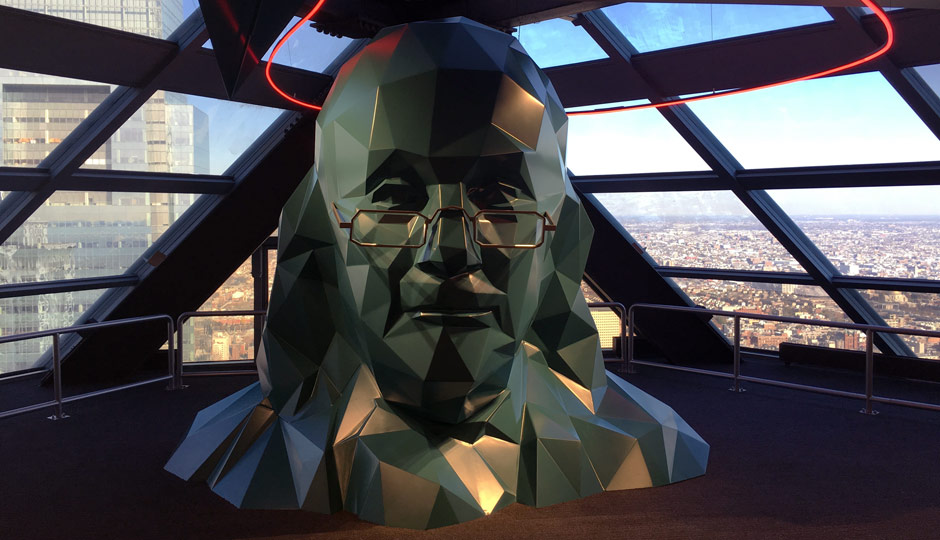PHOTOS: First Look at the One Liberty Observation Deck

A giant geometric Benjamin Franklin head greets visitors at the new One Liberty Observation Deck. (Photo: Dan McQuade)
Philadelphians are going to get to see their city in a new way at the end of the week: From the sky. Eight hundred-and-eighty-three feet above street level, to be precise.
While there has long been an observation tower at Philadelphia City Hall, the city’s taller skyscrapers didn’t have one until now. On Saturday, the One Liberty Observation Deck opens on the 57th floor of One Liberty Place. It will be open from 10 a.m. to 10 p.m. daily, with a capacity of 275 people. Admission is $19 for adults and $14 for children from ages 3 to 11.
“What got me excited about the project was the opportunity to tell a Philadelphia story,” says Evan Evans, general manager of the Observation Deck. “As a hotelier, I realized that there wasn’t one great place to see it all, and learn it all, and give our visitors something to enjoy. And, then, for our locals, we really are unlocking and unveiling Philadelphia in a way they’ve never seen before. And that was as important to me. This is something that most Philadelphians have just never seen.”
Indeed, the observation deck is not just aimed at tourists visiting Philadelphia. Run by Montparnasse 56, which operates several similar decks in Europe, the One Liberty Observation Deck is also looking to capture locals who before now have not been able to see Philly from such a height.
One Liberty Observation Deck

















Walking off the elevator and onto the observation deck, visitors are greeted by a geometric bust of Benjamin Franklin. The deck uses the exposed steel of One Liberty as a feature; workers tore out the drywall that previously covered the beams. With its giant Benjamin Franklin head and exposed beams, the observation deck looks like a modern version of the original identity of Franklin Mills Mall. (The visual work at the mall, built in the 1980s and since renovated into Philadelphia Mills, was done by Milton Glaser, of I [heart] NY fame.)
“The building is such an iconic building,” says architect Mark Brungo, a senior associate with Gensler, of the Helmut Jahn-designed One Liberty. “We took a nod from the geometry of the building itself when we designed the space. All of the interior walls, we made them angled… as a nod to the building itself, and also to help the flow of customers through the space. We also chose to leave the structures exposed as an architectural element, as opposed to concealing it. That way when people, as they meander through the space, they can experience the building itself.”
The Max Headroom Ben Franklin head at the top references a pair of giant legs (complete with size-96 feet) on the second floor of Liberty Place, which visitors see before being whisked up an elevator to the top. Every four minutes, in a nod to Franklin’s famous kite and key experiment, there’s a simulated thunderstorm.
At the top of the observation deck are several interactive kiosks with touch screens that feature a panorama of the cityscape. There are also three “chair zones” where Philadelphia radio personalities tell stories of the city: Former WXPN DJ Michaela Majoun, man-about-town Jerry Blavat and 97.5 The Fanatic’s Mike Missanelli. There’s even a penalty box at one end.
“There’s a lot of storytelling that happens graphically and visually in the space, and that tells the Philadelphia story,” says Evans. “That was hard. A lot of professionals and a lot of curators had input.”
With hours going late into the night, visitors will also be able to experience a high-up view of the city in the dark. Evans says that’s one of the coolest parts of the observation deck.
“The lights in the city are magnificent,” he says. “They call Paris the City of Lights; well, Philadelphia offers lights in the same way. And when you look at the streets and the layout and how Philadelphia was architecturally laid out, you appreciate the dark spaces of the rivers, the bridges, and the lights of Center City and out into the neighborhoods and then out into the suburbs. It’s really beautiful at night.”